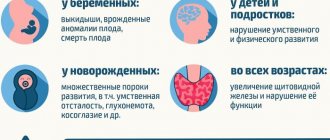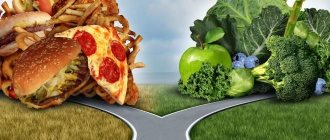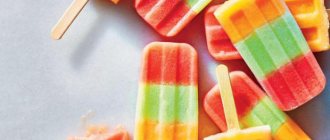Slow glucose (low GI) is beneficial. Eat these carbohydrates every day, even on the most restrictive diet. Forget about counting calories! Allow yourself “healthy” foods without regard to calorie content.
The energy for the activity and vitality of a healthy person’s body always comes from food. Most of the energy needs are met by foods rich in carbohydrates. Carbohydrates are traditionally divided into fast and slow. They are also called simple and complex (or complex). Weight loss occurs if you exclude a maximum of simple “bad” carbohydrates from your diet, leaving “good” carbohydrates on the menu.
Fats, proteins and carbohydrates - what goes with what
Nutritionists have long divided all the products on the human dining table into three general groups:
- Protein food
- Fats
- Carbohydrates
The first includes meat and fish in any form, eggs of all types of birds, legumes, and various nuts. The most powerful and at the same time dangerous source of energy in terms of calorie content are heavy animal fats and vegetable-based oils (including refined ones). Fat enters the body with fish and dairy products, meat and eggs. Finally, carbohydrate-containing products are all types of flour products, sugar and all variety of sweets, potatoes, and cereals. Carbohydrates are in no way compatible with proteins and vice versa.
The main difference between the former and the latter is that for proper digestion of a protein product in the stomach and its high-quality breakdown, the gastrointestinal tract must have an acidic environment, and in order for carbohydrate-type food to be properly absorbed by the body, the environment in the stomach must become alkaline. Thus, when these incompatible food groups are combined on your plate, your stomach will either ignore the first when digesting it, or will not digest the second. This threatens regular digestive disorders, disruptions in the gastrointestinal tract, decreased metabolic rate, diabetes mellitus and negative weight fluctuations.
But the third group - fats - is compatible with both the first and second, but is categorically not recommended for a person losing weight. True, only in some of its product variations. Despite the persistent associations of fatty foods with French fries and hamburgers and, as a result, with extra pounds and blurred waistlines, the “right” fat (which is unsaturated fatty acids) is able to burn out the most hopeless fat deposits from the body. Healthy sources of unsaturated fats include: avocado, fish and white meat, nuts and natural vegetable oils (first and second pressing).
The role of carbohydrates in the body
Macro and micronutrients are important for humans, as they regulate basic processes. There are several functions that carbohydrates perform in the body:
- During the process of breaking down an element, the time and level of energy used by the body increases several times. Thus, more calories are burned.
- Regulate blood glucose levels.
- They increase the supply of glycogen deposits, which the body needs as a source of strength.
- Relieves the body of hunger.
- Nourishes the brain and cells with essential elements.
- They help the intestines function due to their antiseptic and cleansing properties.
Carbohydrates include most types of cereals, grains, fruits, berries, vegetables and grains. The oligosaccharides they contain directly affect the intestines, improving its microflora and overall tone.
It is important to remember that eating a lot of carbohydrates is unhealthy. In this case, a person may encounter the following problems:
- excessive weight gain;
- load on the liver;
- diseases of internal organs;
- problems with the gastrointestinal tract;
- intestinal obstruction and constipation.
What are bad and good carbohydrates
Carbohydrates are organic compounds of carbon and water. The human body will not function fully without regular carbohydrate feeding. Without the intake of carbohydrates, the internal organs will not be able to process either fats or proteins and the liver, the most important organ for enriching blood cells with the necessary substances, will cease to function properly.
Carbohydrates are the main supplier of food for the mind - glucose for the brain.
The division into slow/fast carbohydrates is directly related to the speed of their breakdown by the body and the time of transformation into nutritious glucose. By the way, glucose is precisely the main irreplaceable energy source for the body.
To measure the speed of a car, the mileage traveled is used, divided by the time unit hour - kilometers per hour. To indicate the rate of breakdown of glucose, an equally interesting measurement value has been introduced - the glycemic index.
The importance of fast carbohydrates in nutrition
Do not rush to give up fast carbohydrates with high GI. If consumed in moderation and with strict portion control, they can be beneficial to the body. Although foods with a glycemic index value of 70 or higher provide only short-term benefits, they can be useful because:
- activate brain activity;
- restore the reserve of carbohydrates, which is primarily used up during active exercise;
- fight depression by increasing the level of “happiness” hormones;
- perform a protective function, not allowing harmful substances to enter the body from the external environment.
Fast carbohydrates are a source of energy for athletes, as well as for people engaged in mental activity. They increase endurance, improve brain function, and stimulate concentration.
List of foods with healthy carbohydrates (and glycemic index below 40):
- brown and colored long rice
- unprocessed rice
- wholemeal bread products
- whole wheat noodles
- all types of cereals, with the exception of semolina
- fresh or frozen zucchini
- green spinach and other greens from the garden
- all types of cabbage
- sour fruits (fresh kiwi and grapefruit, orange, and green apple)
- boiled red and green lentils
- all types of soybeans
- beans, beans
- barley porridge
- dried apricots
- plums with peaches
- ripe avocados
- fresh bell and chili peppers
- onions of all types - yellow, red, leek and others
- processed edible mushrooms
- juicy fresh tomatoes
Types of carbohydrates
People forget what carbohydrates are. Organic compounds are divided into 2 groups: with a simple and complex structure. Carbohydrates include saccharides, which are converted into energy or stored as adipose tissue. To protect the body from negative consequences, you should find out which foods contain carbohydrates and which type is more beneficial for the body.
Simple (fast) carbohydrates
Light carbohydrates are absorbed in the body within 15-20 minutes due to their simple chemical structure. The high rate of absorption of organic substances leads to a sharp increase in the plasma concentration of glucose in the blood. To normalize sugar levels, beta cells of the pancreas release large amounts of insulin into the blood. Excess glucose is converted into fat in a molecular ratio of 1:2.
The hormone reduces glucose concentrations to normal levels, so the person begins to feel a repeated attack of hunger. The amount of food and calorie intake increases, which leads to excess weight. If you continue to consume simple carbohydrates, the following side effects may develop:
- constant feeling of hunger;
- load and exhaustion of the pancreas;
- insulin damages the walls of blood vessels;
- increased risk of diabetes.
Complex (slow) carbohydrates
The complex structure of organic compounds is characteristic of plant fiber, animal glycogen, polysaccharides or starch. These substances are more difficult to break down into microelements and convert into energy, so their digestion takes up to 4-6 hours, depending on the metabolic rate and the functioning of the digestive organs.
During this time, the body completely absorbs glucose, transforming it into energy for tissues. At the same time, serum sugar levels do not increase, remaining within normal limits.
In addition, slow carbohydrates have a high energy value, so a person does not feel an increase in appetite. Due to the absence of excess sugar, glycogen is not formed in the liver.
What foods contain complex carbohydrates? Table
The content of carbohydrates with a complex chemical structure is observed in the following products:
- flour products made from wholemeal flour;
- mushrooms;
- unsweetened fruits;
- vegetables;
- cereals, beans;
- leafy greens.
Complex carbohydrates, the table of which contains mainly products of plant origin, allow you to get rid of the feeling of hunger for a long time.
| Products | Amount of carbohydrates per 100 g of product, g |
| Legumes: beans, beans, lentils | 53-55 |
| bitter chocolate | 48 |
| Whole wheat bread | 46 |
| Soybeans | 27 |
| Wheat flour pasta | 23 |
| Cashew | 22 |
| Canned peas | 13 |
| Olives | 12 |
| Pomegranate, sweet and sour apples, celery root, pear | 11 |
| Peach, fresh prunes, gooseberries | 10 |
| Onion, raspberry | 9 |
| Citrus fruits excluding grapefruit and lemon, currants | 8 |
| Kiwi, grapefruit, nuts except cashews | 7-11 |
| Zucchini | 6 |
| White cabbage, cauliflower and Brussels sprouts, broccoli, sorrel leaves, bell pepper | around 5 |
| Radishes, green onions, green beans | 4 |
| Lemon | 3,6 |
| Tomatoes | 3 |
| Cucumber, spinach, leafy greens | 2 |
| Mushrooms | 1-4 |
| Champignon | 0,6 |
How “proper” carbohydrates work
Once in the body with food, they are absorbed into the walls of the gastrointestinal tract and slowly raise blood sugar levels. There are no glucose surges in the body, the person’s mood and condition remain stable and even. In general, don’t want to be considered a nervous and fussy person? Adjust your diet towards the healthiest “slow” carbohydrates.
It is noteworthy that a person starts digesting this type of carbohydrate from the first piece of product that enters the mouth. This is facilitated by a special enzyme produced by human saliva. Therefore, no to stress, yes to weight loss and peace!
List of carbohydrate foods
For the full functioning of all internal organs and maintaining health, you should approach the choice of food responsibly. The food you eat should contain sources of carbohydrates to provide your body with micronutrients, vitamins and minerals. You should not get carried away with low-carb systems for more than a month - this is fraught with health problems. High-quality and healthy nutrition should be balanced and include all nutrients.
Main sources of simple carbohydrates in food:
- sugar;
- honey;
- carbonated drinks;
- flour products;
- sweet fruits.
As a rule, the highest concentration of simple carbohydrates contains a product with a large amount of sugar in its composition. A nutrient can only be useful if consumed wisely. An element included in the “simple” group has a high GI (glycemic index). The body digests it quickly and does not receive sufficient saturation.
Eating foods from this group in large quantities leads to excess weight and increased blood sugar. Foods high in complex carbohydrates:
- bread;
- wild rice;
- whole grain products;
- cereals and cereals.
Products with such carbohydrates can only provide benefits to the body. They satisfy the appetite, eliminate toxins and have a positive effect on blood sugar, brain function, gastrointestinal tract and other organs. It is recommended to consume carbohydrate-containing foods to lose weight and stay in shape.
Content of simple carbohydrates in products
The category of simple carbohydrates includes flour and sweet foods, as well as fruits, berries and honey. It is recommended to exclude them from the diet during the process of losing weight. When consumed in large quantities, health problems may arise:
- bloating;
- sleep problems;
- headache;
- diarrhea;
- vomit;
- liver problems;
- risk of diabetes.
To avoid such ailments, it is recommended to consume foods rich in carbohydrates in moderation and not forget about other microelements. It is advisable to completely exclude from your diet only simple carbohydrates with a high sugar content, such as candies, pastries, and cookies. They are considered harmful to both figure and health, as they excessively increase blood glucose levels. Food products with such carbohydrates should be consumed in limited quantities and in the first half of the day.
Table of simple carbohydrate content in food
| List of products | Amount of element per 100 grams of product |
| Fresh fruits | 50-82 |
| Berries | 10-79 |
| Dried fruits | 65-90 |
| Milk chocolate | 65-83 |
| Honey | 82 |
| Cookie | 50-73 |
| Jam | 70-80 |
| Table sugar | 100 |
| Sweet flour products | 56-89 |
| Candies | 90 |
| Fried potatoes | 29 |
Content of complex carbohydrates in products
Carbohydrates are foods that can affect human health both positively and negatively. Complex carbohydrates have many benefits:
- improve brain function;
- increase concentration;
- deprives you of the feeling of hunger;
- cleanse the intestines of toxins and bacteria;
- help in losing excess weight.
It is recommended to include them in your diet. Foods rich in nutrients help improve digestion, speed up metabolism and prevent certain diseases.
Complex carbohydrates are mainly cereals and grains. Plant foods are rich in nutrients, vitamins and minerals. To maintain health all year round, it is recommended to include in your diet foods that contain complex carbohydrates along with vitamins.
Table of complex carbohydrates in food
| Name | Element content per 100 grams |
| Buckwheat | 56 |
| Barley porridge | 73 |
| Bulgur | 19 |
| Cereals | 55-86 |
| Rice | 31 |
| Wholemeal bread | 53 |
| Peas | 56 |
| Beans | 54 |
| Vegetables | 18-83 |
| Lentils | 53 |
| Teff | 20 |
"Wrong" carbohydrates
As it becomes clear from the explanation of the effectiveness of carbohydrates with an eye to the speed of their absorption, fast carbohydrates (or “death to the diet”) are those that have a high glycemic index. They, of course, are also saturated with a number of vitamins, and they contain microelements. But they have much less benefit than low-index carbohydrates. Therefore, it is not recommended for those who want to lose weight to allow themselves to do so every day. By the way, this type of carbohydrate includes alcohol, which is unloved by nutritionists, in all its variations.
But if you can’t do without “wrong” carbohydrates, then allow yourself delicious desserts, delicious pastries, relaxation with a glass, at least in the format of a very rare “holiday”. Remember, more frequent concessions to your “I want and I will” do more damage not to your waist width, but to your health in general. Thus, the pancreas, which is responsible for the production and supply of insulin, begins to work at the limit of its capabilities as soon as the body is overloaded with such “wrong” carbohydrate foods. As a result, blood sugar jumps, the mood changes from cheerful to tearful, the brain plunges into despondency, and the stressful state and gloomy tension do not go away even after “treatment” with chocolate-covered buns.
Stimulation by serotonin (the hormone of happiness) from the consumption of carbohydrate foods can be avoided to the point of absurdity if you heed the advice of doctors. Cheer yourself up (occasionally) with the following foods.
Carbohydrate needs
Nutritionists claim that the lower level of daily carbohydrate intake is 100 grams per day. At the same time, the need for the element increases:
- with increased mental and physical stress;
- during lactation;
- during pregnancy;
- under active production loads and so on.
With average activity, the body should receive 300-400 grams.
Foods rich in carbohydrates are required in less volume when the body's productivity is low (calm rhythm of life). So, if a person hardly moves and sits in front of the TV all day long or does sedentary work, then carbohydrate intake can be limited to 100 grams/day.
List of foods with a glycemic index above 60:
- honey, propolis, bee waste products
- fresh and canned candied pineapples
- dried raisins
- watermelon
- Yellow banana
- sugar melon
- sweet dates
- pancakes, including store-bought ones
- crackers
- sweet corn flour sticks
- corn flakes, including for children
- instant porridge (oatmeal, etc.)
- potatoes baked in the oven or in the coals of a fire
- homemade/instant potato puree
- boiled carrots
- turnip
- all types of pumpkin fruits and desserts
- white rice
- grain and white bread
- cookies
- couscous, including coarse wheat flour
- semolina
- dry prepared food products (industrial production adds pure carbohydrates - sugar/glucose, as well as starch) to already processed products.
What types are there?
It has already been proven that carbohydrates come in two types:
- Complex. The peculiarity is a longer process of assimilation. This category includes polysaccharides of plant origin (including starch). There is an increasingly common opinion that it is starch that causes weight gain. This is wrong. Polysaccharides are gradually absorbed by the body and normalize the functioning of the gastrointestinal tract. Starch belongs to the “slow” category due to prolonged digestion in the stomach. At the same time, glucose levels remain at a safe level (unlike taking sugar). The less starch is processed before consumption, the better for the body. That is why it is not recommended to cook products containing it for a long time. Thus, carbohydrates include polysaccharides, which are directly involved in the normalization of intestinal microflora. Also included in this category are glycogen and fiber, which have a positive effect on the body, supply cells with energy and ensure normal functioning of the gastrointestinal tract. Slow carbohydrates are found in various foods:
- Starch - in flour products, potatoes, cereals.
- Glycogen (animal type starch) - present in muscles and liver.
- Cellulose. Foods rich in carbohydrates of this type are rye bran, buckwheat, vegetables, fruits, wholemeal bread, and so on.
- Simple. There is another type of carbohydrates - di- and monosaccharides. This category includes sucrose, fructose and other elements. The first thing that deserves attention here is the sugar we are used to, which is formed from a pair of molecules (fructose and glucose). After entering the body, sucrose quickly breaks down, is absorbed and saturates the blood plasma with glucose. At the same time, the body is often unable to use all the substances received, which is why it is forced to transfer them into fat deposits. This situation is possible when monosaccharides are actively absorbed in the intestines, and organs and tissues consume elements at a low rate. Fructose, unlike glucose, does not burden the insulin system, but in case of excessive intake it still leads to fat gain. Many people mistakenly believe that by replacing sucrose with fructose, they will lose weight. This is not true, since both elements belong to the class of monosaccharides and are digested equally quickly. For this reason, it is worth knowing what classifies as carbohydrates and which foods contain mono- and disaccharides. Thanks to this, it is possible to reduce their intake to a minimum and maintain weight at the same level. When purchasing food products, you should pay attention to the content of modified starch. The latter is also processed at high speed (like monosaccharides). At the same time, the rate of absorption is reflected in a special parameter - the glycemic index. Let's summarize. Fast carbohydrates include:
- Glucose - found in grapes, honey, grape juice.
- Sucrose. Sources include jams, confectionery, compotes, and sugar.
- Fructose. Comes with citrus fruits, peaches, compotes, jam, honey, juices and other products.
- Lactose. What foods are rich in these types of carbohydrates? Here it is worth highlighting kefir, milk, cream and others.
- Maltose. Sources: kvass and beer.
How to lose weight with carbohydrates, proteins, fats
Knowledge is power, and separate nutrition is power, assure crowds of men and women who have achieved ideal indicators on the scales thanks to the separate nutrition system. The main advantage of separate nutrition is the absence of strict prohibitions, and therefore, breakdowns. The creator of the system is Dr. Herbert Shelton, famous in the twentieth century.
So, the rules of separate nutrition (or carbohydrate-protein diet):
- Never eat proteins with carbohydrates. The latter should be put into the mouth no earlier than three to four hours after eating protein food.
- A carbohydrate food is one that contains at least 20% carbohydrates. A protein product is one that contains more than 10% protein.
- One meal should contain only 3-4 foods, either protein or carbohydrate. Are you planning to have a healthy vegetable salad for lunch? And it should be prepared with no more than 2-3 ingredients!
- Planning a protein lunch or dinner? Supplement it with a freshly chopped vegetable salad without starch (for example, Chinese cabbage, fresh cucumber, juicy radish, red-sided tomato).
- Avoid combining carbohydrate foods with a GI above 60 with foods containing acids (lemon, apple, grapefruit, tomato).
- Acidic foods are also incompatible with raisins (cottage cheese, fish, etc.).
- If giving up sugar is very difficult, replace it with bee products. Don’t be cunning and buy food with “unnoticeable” sugars.
- No mono diet! No monotonous diet, otherwise there is a high risk of serious harm to your health. On one day, alternate meals as much as possible in different meals.
- Do you want some bread? Eat! But not as a snack to chicken broth or vegetable salad, but as a separate independent product - an autonomous meal.
- For pregnant women, any food experiments and diets are completely prohibited. Restrictions on food and adjustments to the diet of an expectant or nursing mother should occur under the strict supervision of a supervising physician.
Foods containing carbohydrates
To properly build your diet, you should know which foods are carbohydrates. The list below will help you choose the right diet for every day. There are three categories worth distinguishing here:
- Approved for consumption. This includes foods that contain slow carbohydrates or do not contain them at all:
- boiled meat;
- mutton;
- chicken, rabbit;
- ham;
- beef stew;
- eggs;
- pork goulash;
- sausages;
- salted herring;
- smoked salmon;
- boiled fish and so on.
- Allowed for occasional use. Now let's look at which foods are carbohydrates and should be taken in small quantities:
- Vegetables - chickpeas, soybeans, lentils, beets, pumpkin, onions.
- Soups - mushroom, tomato, vegetable, pea.
- Dairy products - kefir, sour cream, milk, yogurt.
- Fruits and berries - plum, kiwi, avocado, peach, fig.
- Not recommended for use. Now let's mention “harmful” foods rich in carbohydrates. The list looks like this:
- baked potato;
- potato chips;
- sweets (cakes, pastries, granulated sugar, marmalade);
- White bread;
- sweet drinks.
Below we will consider an additional list - what refers to carbohydrates (products containing mono-, di- and polysaccharides per 100 grams):
- sugar - 99.9 g;
- bee honey - 80.2 g;
- marmalade - 79 g;
- dates - 69 g;
- pearl barley - 67 g;
- raisins (raisins) - 66 g;
- apple jam - 65 g;
- rice - 62 g;
- buckwheat - 60 g;
- corn - 61.5 g;
- wheat flour - 61.5 g.
Common truths of losing weight
- Eliminate any sugars from your diet.
- Forget about flour and baked goods made from premium flour.
- Throw all purchased processed foods in the trash.
- There is no need for energy bars for athletes; they are easily replaced with natural “correct” carbohydrate products.
- Monitor your blood insulin levels. Its low level starts the fat burning process.
- Carbohydrates - for breakfast, for energy, activity, sports.
- If you have a choice between proteins or carbohydrates for dinner, take proteins (fish, cottage cheese, eggs). This way, insulin will remain at its previous level (there are no sweets on the dinner menu), and the weight loss process will continue even in your sleep!
It is noteworthy that during separate meals you will not have to try to overcome the constant feeling of hunger. You will eat quite normally and eat as much as you need to feel full. You will not experience mood swings, the desire to take a nap, irritability and fatigue.
Without sacrifices, financial costs, psychological breakdowns, and most importantly - practically without effort, you will begin to lose weight and become more active and cheerful!
3 dinners for two with free delivery for RUB 1,990.
View menu
Table of fast carbohydrates in foods with an average glycemic index (55 - 70 units)
In the table below, you will see which foods are fast carbohydrates with a low glycemic index.
| Product | Average GI (units) | Amount of carbohydrates per 100 g of product (grams) |
| A pineapple | 65 | 12 |
| Bananas | 55 | 22 |
| White grapes | 55-60 | 16,8 |
| Red grapes | 65 | 17,2 |
| Black grapes | 64 | 17,5 |
| Melon | 65 | 8 |
| Raisin | 64 | 79 |
| Boiled potatoes | 60-65 | 17,1 |
| Sweet potato | 55 | 20 |
| Kiwi | 55 | 15 |
| Boiled corn | 69 | 18,58 |
| Canned corn | 60 | 12,2 |
| Mango | 55-60 | 15 |
| Papaya | 59 | 9,12 |
| Black Rowan | 60 | 10,9 |
| Fruit salad with whipped cream | 55-60 | 38,18 |
| Boiled beets | 65 | 8,8 |
| Persimmon | 55 | 34 |
| Orange juice in bags | 60-65 | 13 |
| Yogurt with sugar and fruit | 59 | 3,6 |
| Tea or coffee with sugar | 60-65 | 7 |
| Canned vegetables | 65-70 | 33,96 |
| Sweet compote | 60 | 8,9 |
| Mayonnaise | 59 | 0,6 |
| Sour cream | 55-60 | 3,2 |
| Buckwheat | 60 | 72 |
| Cheese | 55-60 | 1,3 |
| Hercules flakes | 65-70 | 61,8 |
| Ketchup | 55 | 26 |
Low GI foods promote weight loss, guarantee a good mood and a feeling of lightness throughout the day.
Now you know what fast carbohydrates are and what foods belong to them. Don’t forget that everything is good in moderation; when creating an individual nutrition plan, try to maintain a balance. Combine simple carbohydrates with complex ones - add a handful of dried fruits or a spoonful of aromatic honey to oatmeal. Eat right and be healthy!
It will also be interesting
- The most expensive cosmetics in the world
- 12 Ways to Improve Digestion with Ayurveda
- Black cumin oil: properties and applications
- Jojoba oil: application
- Winter skin care.











